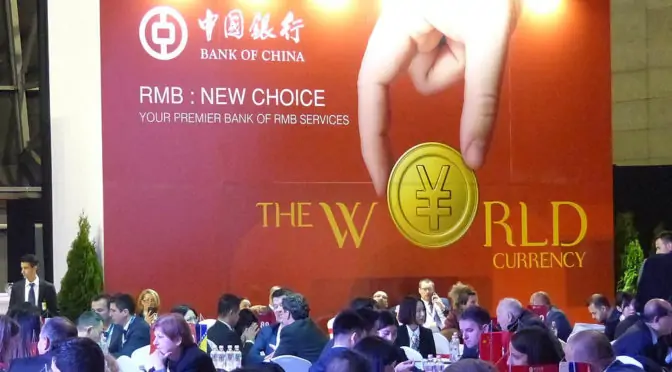China has entered a “new era” where it should “take centre stage in the world” said President Xi Jinping during his opening speech at the 19th National Congress of the Communist Party of China (18-24 October) (Xi Jinping: “Time for China to take centre stage”, BBC News, 18 October 2017). This is poised to have formidable effects on the global economy as well as on the international currency system. Furthermore, to see this happening, we may wonder if the Chinese currency needs not becoming supreme in the international currency system. What is thus the current international state of play for the renminbi and which factors could preside to its future international reign?
Executive Summary
This article focuses on assessing the possibility to see China’s Yuan rivalling or replacing the U.S. dollar as the world’s reserve currency, with all the consequent benefits.
As far as the current position of the “redback” is concerned, our analysis shows an increased internationalization as, for example, the Renminbi has been included in the basket of currencies on which the values of the IMF-issued Special Drawing Rights is based. The U.S. dollar, however, is still much more used in foreign-exchange trading and as a store of value at the official level. The greenback, all things being equal, is therefore likely to retain a dominant position in the foreseeable future.
However, keeping in mind that events rarely remain equal and follow expected trends, as first elements towards detailed scenario analysis for the future, we then analyse certain components of the Chinese economy that could help the renminbi in rivalling the international stance of the U.S. dollar. China’s extensive internal market and Beijing’s commercial depth are likely to help the renminbi in strengthening its position on global markets, while China’s financial markets still seem underdeveloped. This is why China’s economic authorities have announced that they will undertake dramatic reforms. Nonetheless, the facts that the judicial system is still controlled by the Communist Party and that the yuan is not fully convertible could hinder the possibilities for the renminbi to rival the dollar, at least in the short-term.
As a conclusion, the reform of the financial markets will be crucial to establish a truly global currency that could have the possibility to be on a par with the U.S. dollar, the two coexisting at the top of the currencies’ ladder. Other events, however, deserve further consideration for a fully detailed and final estimate.
Full article 2605 words – approx. 6 PAGES
Access for non-members or for your package is limited.
To continue reading, become a member of The Red (Team) Analysis Society.
If you are already a member, please login (don’t forget to refresh the page).
Featured image: China-CEEC Matchmaking Event 2017. Taken on the 27th of November, 2017 by Elekes Andor (Own work) [CC BY-SA 4.0 (https://creativecommons.org/licenses/by-sa/4.0)], via Wikimedia Commons.
About the author: Leonardo Frisani (MA Paris) focuses currently on challenges to the US Dollar supremacy. Beyond that, his specialisation is in international security, and his main interests are in geopolitics, macroeconomics, climate change, international energy and history.
Main references:
Bank for International Settlements (2016) Foreign Exchange Turnover in April 2016, Triennal Central Bank Survey, Monetary and Economic Department: September 2016.
Blinken, A. J. (2017), “Trump is Ceding Global Leadership to China”, The New York Times, 8 November 2017.
Bradsher, K. (2015), “China’s Renminbi Is Approved by I.M.F. as a Main World Currency”, The New York Times, 30 November 2015.
Eichengreen, B. (2017), “The Demise of Dollar Diplomacy?”, Project Syndicate, 11 October 2017.
Eichengreen, B., Mehl, A,. and Chitu, L. (2012), “When did the dollar overtake sterling as the leading international currency? Evidence from the bond markets”, Vox, 23 May 2012.
Frankel, J. (2013), “The latest on the dollar’s international currency status”, Vox, 6 December 2013.
Frisani, L. (2017), “Challenges Looming Over the Petrodollar System”, The Red (Team) Analysis Society, 20 November 2017.
Galbraith, A. (2017), “Foreign holdings of Chinese debt up in July, Bond Connect impact limited”, CNBC, 3 August 2017.
Lavoix, H. (2017), “Signals: China’s Xi Jinping Thought, Real Economy And… Global Finance”, The Red (Team) Analysis Society, 24 October 2017.
Maavak, M. (2017), “My Say: Is China set to junk the global dollar hegemony?”, The Edge Markets, 28 September 2017.
Mutethya, E. (2017), “2nd China-Africa Investment Forum begins in Morocco”, China Daily, 28 November 2017.
Nakazama, K. (2017), “Communist China’s Third Era: 2012 to 2035?”, Nikkei Asian Review, 4 December 2017.
O’Neill, J. (2017), “What’s Really at Stake at the CCP Congress?”, Project Syndicate, 18 October 2017.
Prasad, E. (2017), “The Perils of a Trumped Fed”, Project Syndicate, 27 October 2017.
Ren, S. (2016), “Move Over Oil, Gold: 7 Of Top 10 Commodities Futures Are Now Traded In China”, Barron’s, 4 May 2016.
Roach, S. S. (2017), “Rethinking the Next China”, Project Syndicate, 25 May 2017.
Sanderson, H. (2016) “China launches renminbi-denominated gold benchmark”, Financial Times, 19 April 2016.
Spence, M. (2017), “The Global Economy’s New Rule Maker”, Project Syndicate, 29 August 2017.
Subacchi, P. (2017), “Why the Renminbi Won’t Rule”, Project Syndicate, 20 October 2017.
Valantin, J. (2015), “China and the New Silk Road: the Pakistani Strategy”, The Red (Team) Analysis, 18 May 2015.
Valantin, J. (2017), “Artificial Intelligence on the Chinese Silk Road”, The Red (Team) Analysis, 4 December 2017.
Wildau, G. and Lockett, H. (2017), “China pledges to open finance sector to more foreign ownership”, Financial Times, 10 November 2017.
Yao, K. and Glenn, E. (2017), “China’s central bank warns of ‘Minsky moment’ as economy powers ahead”, Reuters, 19 October 2017.
Yongding, Y. (2017), “Should China Deleverage?”, Project Syndicate, 29 June 2017.
Zhao, C. (2017), “Stop worrying about Chinese debt, a crisis is not brewing”, Financial Times, 4 December 2017.


